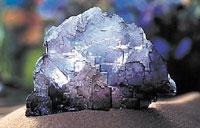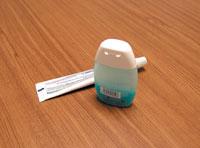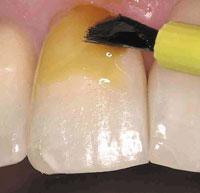Fluoride, the most cooked of the cooked

Fluoride is a strange atom. It is not like other halogen. It is not like any other of its size or like any other. Once glued can not be released: attached forever. It is very difficult to remove fluoride, and the chemicals know it perfectly, so they must have a compelling reason to allow its mixture with the rest of the laboratory substances.
However, the first glass wells that tried to treat fluorite did not know what they were working with. According to a story, a manufacturer of these wells with glasses put in the fire a wonderful blue mineral with the intention of melting it. From there he would take out a nice blue glass to impress his companions. When burning the stone the smoke blurred the glasses. But when he tried to clean it he realized that it was not fuzzy, the smoke "ate" the glass of the glasses. Who is the culprit?
Whether the story is true or not, it is very credible. The smoke from this mineral when burned is a hydrogen fluoride (HF), a compound that attacks the glass. Therefore, chemicals cannot handle them with glass tools. That is curious. And the work is complicated if you want to use molecular fluoride (F 2), which is more reactive than hydrogen fluoride.
Fluoride in nature
It is not difficult to find fluoride in nature. It has been calculated to be the thirteenth most abundant element on the earth's surface. However, this data is not representative in itself, since there are few elements in a high proportion and fluoride is not one of them. We will have to use another reference.

It may help you better understand things: even if it seems surprising, on the surface there is more fluoride than carbon; this is significant, especially considering that carbon is the fundamental element of all life forms. Moreover, compared to elements of the same chemical group, fluoride is more abundant than chlorine, bromine and iodine, that is, it is the most abundant halogen element.
These amounts vary greatly in marine waters, of course, the most abundant halogen is chlorine, since salinity gives it to the sea mainly sodium chloride. However, it is estimated that in the sea there is more carbon than fluoride.
In nature, most of the fluoride is found in the form of mineral, mainly in the form of fluorite. Fluorite has been very important in the metals industry as it was used in metal extraction techniques from stones for stone liquefaction. In fact, the word "fluor" comes from the Latin word that means flow. Otherwise, apatite and creole also contain fluoride among its components.
Little fighter
The fluoride atom is really frightening. It is the most electronegative element, that is, it has the greatest ability to attract electrons, including yours. Therefore, these electrons are very close to the nucleus and the atom is very small. This may not say anything to what is not chemical, but we must think that all chemical bonds are related to electrons, so by attracting electrons chemical bonds are facilitated and, once linked, fluoride is very close to the core of the other atom. Fluoride therefore forms very strong and difficult to break joints. And it's just a way of saying it.

Fluoride reacts with each and every element of the periodic table, except with helium, neon and argon. From this point of view, fluoride is also a special case. It is, among others, the most violent oxidizing element known; it can oxidize oxygen itself. All this entails interesting chemical applications, if the problem is not that the resulting product is fluorine.
Perhaps the most spectacular of these applications is the propulsion of rockets, which use fluoride to help oxidize fuel. However, the element has other uses in the appliances we use at home any day.
Pans, for example, must have a fire-resistant material, made by the fluoride setatía, a famous material called tefloi, which is only a polymer with many fluoride atoms. (Teflon was found by chance in 1938 by Roy Plunkett of the Du Pont company, while testing a new refrigerant.) This small element is "stuck" in an incompact way, so even if it is on fire every day it is not destroyed. Of course, the first applications of this material were not pans, but war material.
Due to this adhesiveness of the fluorine atom other applications to the small element have been found. In archaeology, for example, it is used to date fossil bones using the technique called fluoride test. With the help of groundwater, the bone absorbs fluoride over time, so you can know the time that has passed through the subsoil depending on the amount of fluoride absorbed.
Fluoridated health
In the verb fluor, what comes to people? Most probably associate toothpaste, many of them will also be remembered with drinking water treatment. However, these are health issues.

Given the characteristics of the element, it is not surprising that some consider it a "poison". However, keep in mind that fluoride is essential in mammalian metabolism. It plays important functions at a certain concentration, which is logically very low, that is, it is on the list of necessary trace elements. For example, the human body should always contain about 2-3 mg of fluoride.
Saying it is necessary by experts can cause confusion. Is fluoride not bad? Why then is it necessary?
Fluoride is neither good nor bad. It performs a series of physiological functions that cannot fulfill any other element. Therefore it is necessary. However, these functions involve very small amounts of fluoride, and excess also causes damage.
Therefore, as with other elements, the body needs a quantity of fluoride. However, it is not clear what the functions of this particular element are, since there are sources that show that it is not essential in the human body. In addition, patients with fluoride deficiency have never been found. Scientists have caused this shortage in animals, causing nutrition and growth problems.

However, experts recognize that fluoride contributes to bone and, above all, dental health. In addition, a number of functions have been proposed, including those related to fertility, in addition to being necessary in blood, spleen, skin, hair, nails and iris.
On the other hand, fluoride accumulation disease is well known: fluorosis. Symptoms of this disease occur in bones and airways. Osteosporosis occurs and bones and teeth become very fragile. In the airway, fluoride produces an effect similar to that of silicosis. Finally, in extreme cases, the patient is very thin and can develop caquexi, a disease related to malnutrition. The treatment is intermediate to salts with calcium, taking advantage of its great chemical affinity with calcium.
To enrich uranium, make war How is the atomic bomb manufactured? The simplest way is to start from uranium, which has a large nucleus and bombarded with neutrons causes a great fission reaction, but not all uranium behaves like that, only radioactive uranium is 'fissioned', that is, about 0.7% of what can be collected in nature. Therefore, pumps must 'purify' or 'enrich' radioactive uranium. Fluoride is involved in this process. |
Drinking water
However, the public use of fluoride has generated intense debate in recent years. Due to the anti-cancer properties, many administrations decided to add fluoride to drinking water. This measure is especially beneficial for children. However, because large amounts of fluoride pose a danger, in many villages this decision has been revised and public water is prohibited. What are these risks?
According to studies conducted in recent years, older people who drink fluoridated water daily, bones become brittle, more fragile than normal; the likelihood of hip fracture in these people is higher than normal. Moreover, for patients with nephrosis, diabetes or osteoporosis, fluoridated water is very harmful. According to the researchers, the influence of fluoride increases with heat and, for example, can be greater in tropical populations than in Europeans.

It is not surprising that debates arise on water fluoridation. It may benefit most but not all. In fact, on the Internet you can read arguments and opinions in favor and against. These two websites are, for and against the debate, respectively: www.bracesinfo.com/gedent/fluoride.htm www.nofluoride.com
But in addition to drinking water, our society uses fluoride in many applications. As in chemical compounds, the cooked element has "stuck" to our society and will be difficult to eliminate, difficult or impossible.
Ozone and fluorine There is a family of substances with an enormous capacity to “eat” the ozone layer. They are very light compounds, which are used among others as refrigerants and which once loose are easily accessible to ozone. Unfortunately, they react with ozone in a surprising proportion: one of them can destroy millions of ozone molecules. They are usually called CFCs. And what does the acronym CFC mean? They are chlorofluorocarbons… no wonder the fluoride is involved in it. |
Buletina
Bidali zure helbide elektronikoa eta jaso asteroko buletina zure sarrera-ontzian











